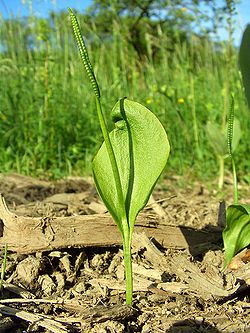| Ophioglossum vulgatum | |
|---|---|

| |
| Scientific classification | |
| Kingdom: | Plantae |
| Clade: | Tracheophytes |
| Division: | Polypodiophyta |
| Class: | Polypodiopsida |
| Order: | Ophioglossales |
| Family: | Ophioglossaceae |
| Genus: | Ophioglossum |
| Species: | O. vulgatum
|
| Binomial name | |
| Ophioglossum vulgatum | |
Ophioglossum vulgatum, commonly known as adder's-tongue,[1] southern adder's-tongue or adder's-tongue fern, is a species of fern in the family Ophioglossaceae.[2]
The chloroplast genome was reported to have a size of 138,562 base pairs.[3]
Ophioglossum vulgatum grows from a rhizome base to 10–20 cm tall (rarely to 30 cm).[citation needed] It consists of a two-part frond, separated into a 4-12 cm rounded diamond-shaped leaf sheath and narrow branchless spore-bearing spike.[4] The spike has around 10-40 segments on each side.[citation needed]
It reproduces by means of spores.[4]
Linnaeus described adder's-tongue with the binomial Ophioglossum vulgatum in his Species Plantarum of 1753.[5]
It is native to many regions with a wide scattered distribution: throughout temperate through tropical Africa and throughout the temperate Northern Hemisphere in Europe, northeastern North America, temperate Asia, and Eurasia.[2][6]

This small, hard-to-spot plant can occur singly in unimproved pastures, rock crevices and grassy path-sides, but also can occur in colonies of hundreds of plants in sand dunes.[citation needed]
In Finland, unlike elsewhere, it grows on seashores, unlike other parts of the world where it tends to be a calciphile. Finland has fitting lime rich soil habitat sparsely, but the plant has found an equivalent living habitat from Finland's seashores affected by a post-glacial rebound: land just risen from the sea is often quite neutral and contains mineral salts in addition to being open and bare enough.[4]
This species is rare in most European countries. In Ukraine, there were recorded 280 loci: 152 before 1980, after 1980 – 120, as before and after 1980 – 8 locations.[7]
Traditional European folk use of leaves and rhizomes as a poultice for wounds. This remedy was sometimes called the "Green Oil of Charity". A tea made from the leaves was used as a traditional European folk remedy for internal bleeding and vomiting.[8]
6. [1]